|
|
|
ADVERTISEMENTS
|
|
PREMIUM
- HAPPY HOLIDAYS!
- Siliconeer Mobile App - Download Now
- Siliconeer - Multimedia Magazine - email-Subscription
- Avex Funding: Home Loans
- Comcast Xfinity Triple Play Voice - Internet - TV
- AKSHAY PATRA - Bay Area Event - Sat. Dec 6
- Calcoast Mortgage - Home Loans
- New Homes in Silicon Valley: City Ventures - Loden Place - Morgan Hill
- Bombay to Goa Restaurant, Sunnyvale
- Buying, Sellling Real Estate in Fremont, SF Bay Area, CA - Happy Living 4U - Realtor Ashok K. Gupta & Vijay Shah
- Sunnyvale Hindu Temple: December Events
- ARYA Global Cuisine, Cupertino - New Year's Eve Party - Belly Dancing and more
- Bhindi Jewellers - ROLEX
- Dadi Pariwar USA Foundation - Chappan Bhog - Sunnyvale Temple - Nov 16, 2014 - 1 PM
- India Chaat Cuisine, Sunnyvale
- Matrix Insurance Agency: Obamacare - New Healthcare Insurance Policies, Visitors Insurance and more
- New India Bazar: Groceries: Special Sale
- The Chugh Firm - Attorneys and CPAs
- California Temple Schedules
- Christ Church of India - Mela - Bharath to the Bay
- Taste of India - Fremont
- MILAN Indian Cuisine & Milan Sweet Center, Milpitas
- Shiva's Restaurant, Mountain View
- Indian Holiday Options: Vacation in India
- Sakoon Restaurant, Mountain View
- Bombay Garden Restaurants, SF Bay Area
- Law Offices of Mahesh Bajoria - Labor Law
- Sri Venkatesh Bhavan - Pleasanton - South Indian Food
- Alam Accountancy Corporation - Business & Tax Services
- Chaat Paradise, Mountain View & Fremont
- Chaat House, Fremont & Sunnyvale
- Balaji Temple - December Events
- God's Love
- Kids Castle, Newark Fremont: NEW COUPONS
- Pani Puri Company, Santa Clara
- Pandit Parashar (Astrologer)
- Acharya Krishna Kumar Pandey
- Astrologer Mahendra Swamy
- Raj Palace, San Jose: Six Dollars - 10 Samosas
CLASSIFIEDS
MULTIMEDIA VIDEO
|
|
|
|
|
COVER STORY
Anatomy of a Terrible Betrayal: The Bhopal Tragedy
In a recent verdict, senior managers of Union Carbide were let off with a surprisingly light sentence for their role in the 1984 gas leak in Bhopal.
Amid public outrage, the Indian government hastily set up a ministerial panel, but their recommendations are a betrayal of the victims and survivors of the gas leak for over 25 years, writes Nityanand Jayaraman.
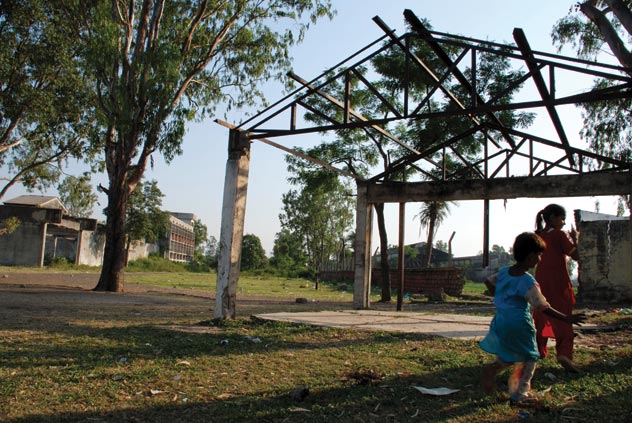
Kids play in the shadows of the abandoned Union Carbide factory [LAUREN FARROW photo]
Rashida Bee is not an unknown entity. Leader of a trade union of gas affected women, winner of the Goldman Environment Prize along with her Hindu behan Champa Devi, this Bhopali has inspired many with her articulate speeches, home-grown wisdom and persistent fight for the rights of Union Carbide’s victims. With the prize money, the duo has set up the world’s first awards for women fighting against corporations. This fiercely anti-corporate woman, though, swears by the product of one chemical company – European transnational Aventis’ anti-inflammatory painkiller Combiflam. “In a day, I take 10 to 12 pills just to keep me going. Combiflam for aches and pains, Losar for (high) blood pressure, and Restyl because I can’t sleep. There are some other medicines, but I don’t remember the names,” the 56-year-old Bhopal survivor-turned-activist says. The long-term effects of exposure to Union Carbide’s poisonous gases has made Bee a habitual pill-popper, and she is not even among the worst affected.
Her family was hit badly by the gas leak. Most of them managed to escape death that night on Dec. 2, 1984. But by 2001, six members of her joint family had succumbed to various cancers. “My abba (father) died in 1987. My bhabhi, elder brother’s wife, died in ‘88. She was 36. My 37-year old sister died in ‘87. Her daughter, who was 12 at the time of the disaster, died just recently, in 2001. Another daughter died in 1989 of brain tumor, and the third daughter died at 55 in 1999,” Bee narrates.
At the time of writing, two weeks have passed since the infamous verdict of June 7, 2010, where eight senior managers (all Indian) of Union Carbide India Ltd were sentenced to two years in jail and a fine of $2,000. They were let off on bail within hours after paying Rs. 25,000 ($550). For the more than 500,000 Union Carbide victims who received less than the bail amount as compensation for life-long ill-health, the verdict was merely the latest in a series of betrayals spanning nine prime ministers.
So it was with a jaded, cynical Bhopali eye that survivors saw the usually cocky Manmohan Singh government buckle under the media onslaught and public outrage. The prime minister directed a newly formed Group of Ministers (GoM) on Bhopal to come up with options to address the Bhopal crisis. Media reports acknowledge that this was meant to deflect the adverse media glare that was building on Rajiv Gandhi’s alleged role in granting erstwhile Union Carbide CEO and U.S. citizen Warren Anderson safe passage out of India.
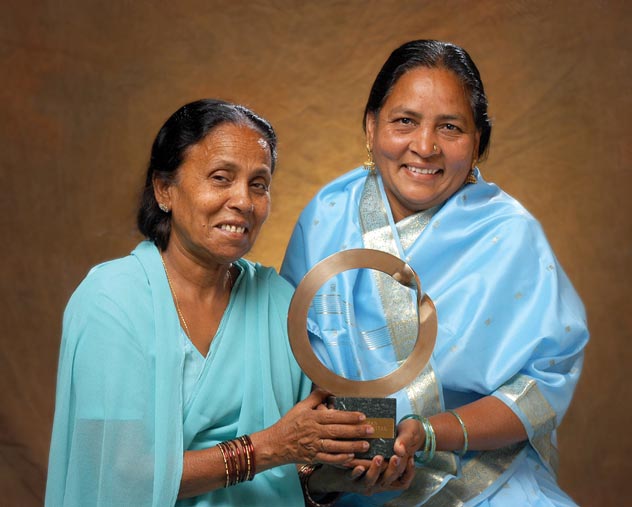
Champa Devi Shukla (left) and Rashida Bee with Ouroboros statuette. [Goldman Environmental Prize photo]
On June 21, Bhopalis were given teasing glimpses of a compensation, liability and clean-up package recommended by the GoM that would turn out to be the latest in the series of betrayals. Many media commentators cautiously welcomed the GoM’s alleged recommendations as a tiny step ahead. Others wondered why only a tiny step was possible when the issues facing the victims had been getting worse by the year for the last 26 years. On all counts, the state and central government and the judiciary have failed the victims. Consider this: 20,000 people still drinking poisoned water; 10,000 victims who were promised jobs are jobless; medical treatment for indigent victims remains elusive; the site, its surroundings and the groundwater are polluted; the culprits — Dow Chemical and Union Carbide — are profiting from business in India; Warren Anderson is at large.
Look at the Group of Minister’s package in this context. Prominent among its recommendations is Rs. 7 billion trotted out as additional compensation. Rs. 1 million for the kin of deceased; and between Rs. 100,000 and Rs. 500,000 for those with varying degrees of effect. “It sounds good, and that is all it is meant to,” says an angry Rashida Bee.
The devil, though, is in the details.
Rashida and the next of kin of the six who died of cancer will get nothing under the current package.
Others like her, who got a paltry Rs. 25,000 (about $500 at current exchange rates) each for belonging to a category termed “not injured,” will also get nothing. Her dead kin, all of whom succumbed to cancer, were also diagnosed as “not injured” based on their condition in the immediate aftermath of the disaster.
She lays out the facts. Around 574,000 gas victims received varying levels of compensation based on a highly flawed system of identifying persons as not injured, temporarily injured, partially or totally disabled and deceased. Many of those considered not injured at the time quickly contracted gas-related illnesses. Some, like Rashida’s kin, succumbed.
Leaked details of the GoM’s recommendations reveal that only 45,166 people will be eligible for a piece of the Rs. 7 billion pie, she explains. And 530,000, identified as “temporarily injured” or “not injured,” will be left sucking their thumbs and to fend for themselves.
Syed M. Irfan, leader of another prominent victim’s organization, is eligible to benefit from Chidambaram’s smokescreen largesse. A frail man with rheumy eyes and a racking, rasping cough, Irfan spends as much time admitted in the public hospital as he does outside. “I’m entitled to four lakhs (Rs. 400,000). But I’ll believe that when I get it,” he says. “Money aside, I need to rid myself of my illness. I can’t afford it. What about that?” he asks.
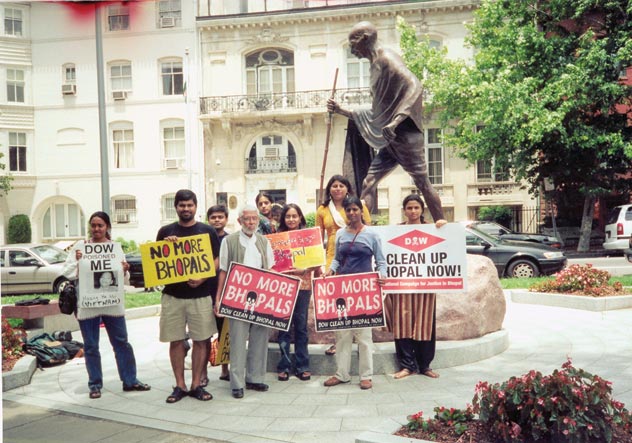
Protester demonstrate June 2004 outside the Indian Embassy in Washington demanding that Dow clean-up the area surrounding the Union Carbide facility in Bhopal. [SEKHAR JAMMALAMADAKA photo]
A skeptical Irfan says, “I smelled a rat the minute I heard the GoM was going to dole out compensation. I knew it couldn’t be right. Why would it be? Mr. Chidambaram was a finance minister. He is a companywala, a numberwala. I knew there would be number juggling,” Irfan said. “It appears there is nothing in this for most of the people of the 36 gas-affected [municipal] wards.”
Even if the promised Rs. 7 billion ($15.5 million) were divided equally among the 574,000 claimants, each would only get 12,195 rupees and 12 paise .
Contrast this to the Rs. 669 billion ($15 billion) hand-outs merely through corporate income tax foregone in 2008-2009 under the aegis of GoM chairman Chidambaram. And this is not a once-in-26 years hand-out. It happens every year. In 2009-2010, about Rs. 796 billion ($17.7 billion) was the tax windfall for corporates — or Rs. 7 billion every fourth day. A one-time payout of just half the corporate hand out — Rs. 300 billion — would be sufficient to put Rs. 500,000 in the hands of every one of the 600,000 affected people. That includes people whose claims have been ignored.
Besides money, the government is yet to come up with a foolproof mechanism to plan and deliver effective medical, social and economic rehabilitation schemes. More than Rs. 5.7 billion has already been spent on rehabilitation by the state government with nothing to show for it. Rather than address the systemic lapses and the failure in accountability mechanisms that led to this colossal waste, the central government is contemplating handing over more than Rs. 11 billion to the same state government for more of the same rehabilitation.
The Bhopalis’ call for an independent Empowered Commission with powers to plan, execute and oversee rehabilitation was accepted by the Group of Ministers in June 2008, but finds no mention in the current GoM’s recommendations.
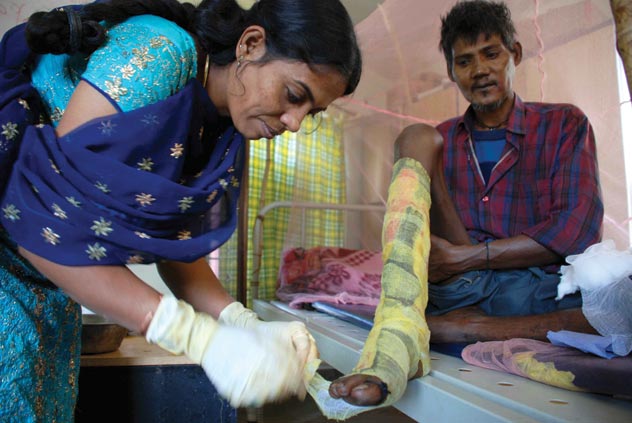
A patient receives treatment at the clinic. [LAUREN FARROW photo]
Covering Up on Clean-up
The GoM has proposed that the center will advance Rs. 3 billion ($66 million) to facilitate clean-up. Dow’s liability will be left for the Madhya Pradesh High Court to decide. Dow’s counsel and Congress spokesperson Abhishek Singhvi says Dow will not submit to the jurisdiction of an Indian court, and the government has done nothing to challenge that. Meanwhile Dow’s CEO regularly meets the prime minister, Ratan Tata, Montek Singh Ahluwalia and various finance ministers and urges them to ensure that nothing is done to challenge Dow’s presence in India.
Issues of liability aside, the government’s plans to deal with the contamination are fraught with problems. Consider the offer of technical assistance from the Nagpur-based National Environmental Engineering Research Institute. NEERI’s science has been called into question more than once. In 1990 and 1997, NEERI authored two scientifically problematic studies on contamination in Bhopal. The earlier study concluded that Carbide’s toxic dump had not contaminated the soil or groundwater in the vicinity. Samples of groundwater and soil taken by Carbide a year earlier were found to be highly toxic. In 1997, NEERI’s study again concluded that groundwater was not contaminated, that it was of drinking water quality and that the contaminants would not reach the aquifer for another 23 years. Just two years later, a Greenpeace study confirmed the presence of carbon tetrachloride, chloroform and chlorinated benzenes in groundwater samples taken just outside the factory.
But NEERI is reported to have told the GoM that water contamination outside the factory was not caused by Carbide’s toxic waste. Tim Edwards, a trustee of the Bhopal Medical Appeal and a long-time Bhopal activist based in London, says: “NEERI’s role in Bhopal has been, to speak generously, one of unparalleled incompetence. Either that, or it has wilfully sacrificed tens of thousands of men, women and children to daily exposure to lethal chemicals.”
NEERI’s questionable role has extended beyond Bhopal. In Kodaikanal, a hill station in Tamil Nadu, the scientific institution stands accused of conflict of interest and of imperiling sensitive ecosystems.
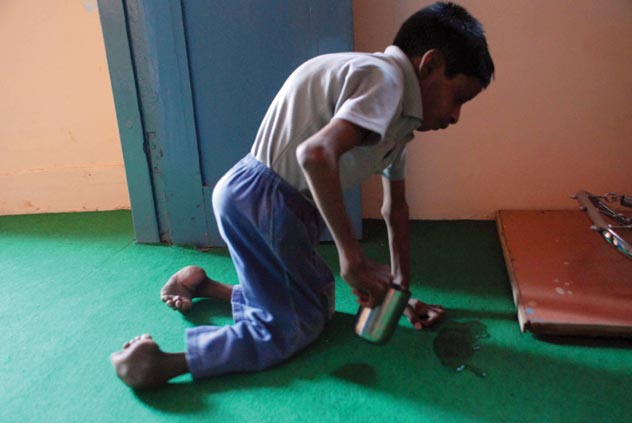
Aadil Khan, 18, crippled by the effects of cerebral palsy. [LAUREN FARROW photo]
In 2001, Anglo-Dutch multinational Unilever’s mercury thermometer factory in Kodaikanal was found to have seriously contaminated its factory site and nearby forests with mercury. NEERI came in 2004 as part of a Supreme Court Committee on hazardous wastes. Within a year, it had landed at least two key consultancy contracts with Unilever for site assessment and project management of clean-up. This was in violation of the Supreme Court Committee’s own direction that the consultant should be engaged by the regulatory agency, not Unilever. Not only that, serving as consultant, NEERI brought down clean-up standards for mercury in soil to a level that would leave behind more than 100 kg of mercury in the factory soil even after clean-up. The standards proposed by NEERI were 25 times lower than what London-based Unilever would have had to apply had the contamination occurred in the United Kingdom.
NEERI’s argument for not applying a more stringent standard relates to the financial health of its corporate client, rather than public or environmental health. Its 2007 report on soil remediation in Kodaikanal says: “The benefits likely to accrue out of stricter norms are to be compared against the additional cost that may be incurred while undertaking such projects.”
The Rs. 3 billion set aside for Bhopal clean up is a pie-in-the-sky figure. No comprehensive assessment of depth and spread has been conducted. No idea exists of the quantum of groundwater that requires remediation. Without an idea of the quantity and kinds of chemicals contaminating various media, it is not possible to estimate the cost of removal, treatment and disposal of the various waste streams.
Interestingly, at least 23 European Parliament MPs from the U.K., Spain, Germany, France and Holland, have renewed a December 2009 offer of technical support with site assessment. The government has not accepted this offer.
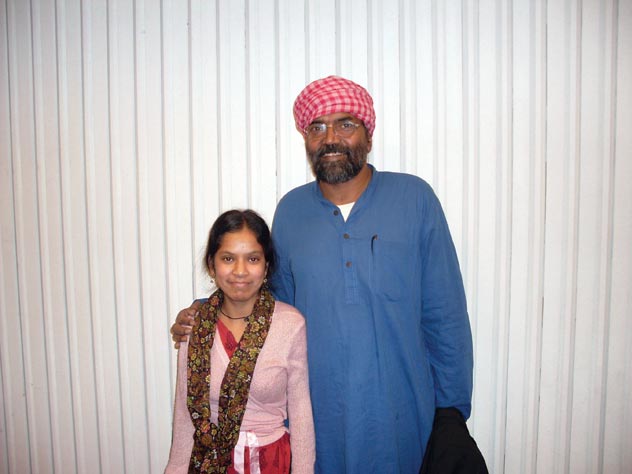
Safreen (l) with Sathyu, who founded Sambhavna, the free clinic that provides alternative medical therapies to adult survivors of gas and water exposure in Bhopal. Safreen Khan is seventeen and grew up in Bhopal. Despite having respiratory problems, she walked 800 km (500 miles) to the prime minister’s house to draw attention to the problems that she and others in her generation face. She helped organize the sending of paper hearts to the Indian PM – hoping to inspire him to help bring justice to the children of the tragedy.
Problems of the Spine
In 2006, Bhopalis walked 500 miles from Bhopal to New Delhi and sat in protest for nearly a month before the prime minister met them. He reluctantly conceded some of the demands, but drew the line on taking any proactive action against the corporate criminals. “We have to do business. We have to move ahead. India has to survive despite these tragedies. Please leave politics to politicians,” Singh said that April afternoon in 2006.
The Bhopalis didn’t understand the significance of Singh’s statement until information unearthed through the Right to Information Act revealed that India was not only doing business, but was actively plotting ways for Dow Chemical and Union Carbide to expand their business in India.
Within months of the Bhopalis’ protest in New Delhi, Ratan Tata swung into action. He wrote to the prime minister, Montek Singh Ahluwalia and the finance minister offering his services to clean-up the Bhopal site. This proposal was enthusiastically endorsed by the finance minister, commerce minister and Montek. Only after irate Bhopalis asked Tata to clean-up the toxic legacies created by Tata group companies in Sukhinda, in Jugsalai, near Jamshedpur, and in Mithapur, Gujarat, was the offer withdrawn. A charitable clean-up shuts out the possibility of recovering the costs from the polluter, while a clean-up sponsored by the government still allows post facto recovery of costs.
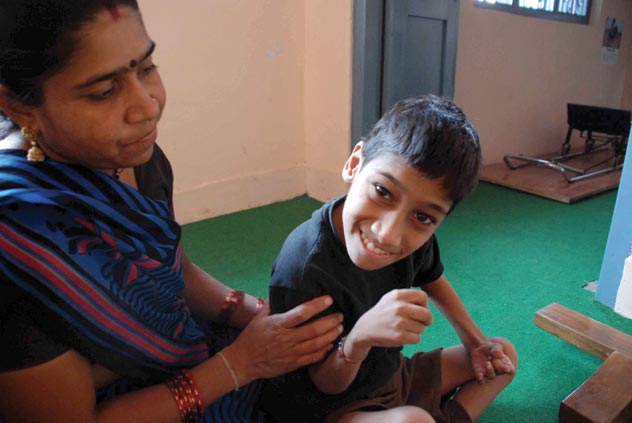
The new generation of Bhopal victims. [LAUREN FARROW photo]
In November 2009, Tata Consultancy Services and Dow Chemical announced a global business alliance where TCS would provide consultancy to Dow’s facilities and joint ventures worldwide.
Indian government representatives periodically send signals to Dow indicating it is welcome to do business in India. On October 25, 2006, the finance minister participated in the India-US CEOs Forum at New York. As a measure meant to welcome Dow, Chidambaram (erstwhile minister) “specifically mentioned to the CEO of the Dow Chemical Company that their proposal for a foreign collaboration with M/s Reliance Industries, which was held up for some time, had recently been approved.” In a letter he wrote to the prime minister regarding the New York meeting, he says: “This was widely appreciated as a step towards resolution of the issues relating to Union Carbide/Bhopal.”
Interestingly, the technology collaboration approved — namely, UNIPOL-PP — belonged to Union Carbide Corporation, bringing the fugitive company $46 million in revenues. In 1992, the Bhopal magistrate’s court had proclaimed UCC as an absconder along with Warren Anderson. But that didn’t stop Carbide from doing business. Just between 1995 and February 2001, Carbide was able to do more than $15 million in business in India. An additional $4 million was transacted as business in just four years after Dow Chemical took over.
All the noise about pursuing the extradition of Warren Anderson is a red herring. In the 18 years that he has been a fugitive, the Indian government has issued an extradition notice only once in 2003. Even that was done only after Bhopalis began an indefinite fast in New Delhi. In the same period, the government has done nothing to pursue the appearance of Union Carbide Corporation. Until 2001, they had little option to enforce Carbide’s appearance to face trial in the criminal case. But after Dow’s takeover of the fugitive, the government had the option to pressure Dow to produce its subsidiary in court. It has not chosen to do so.
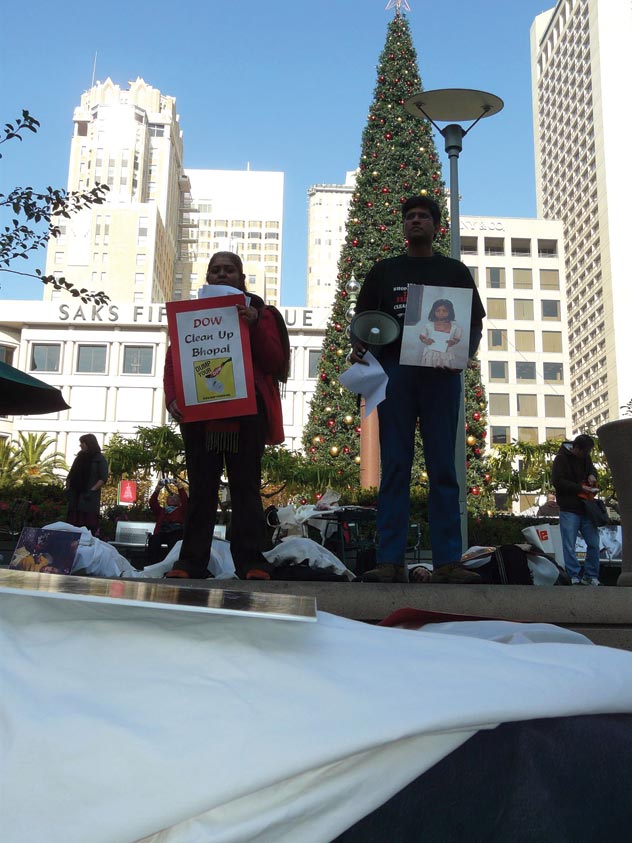
Protesters in San Francisco’s Union Square demonstrate in support of victims of the Bhopal gas leak in 1984, the world’s largest industrial disaster.
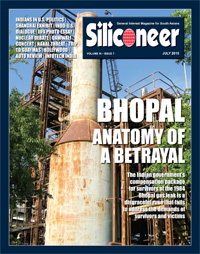 (Cover photo): The abandoned Union Carbide factory. A poisonous gas leak in December 1984 led to the world’s largest industrial disaster. In addition to thousands of immediate deaths, even today 20,000 people are still drinking poisoned water, 10,000 victims who were promised jobs are jobless and medical treatment for indigent victims remains elusive. (Cover photo): The abandoned Union Carbide factory. A poisonous gas leak in December 1984 led to the world’s largest industrial disaster. In addition to thousands of immediate deaths, even today 20,000 people are still drinking poisoned water, 10,000 victims who were promised jobs are jobless and medical treatment for indigent victims remains elusive.
In 2005, activist organizations in Bhopal filed an application in the criminal case pleading that Dow Chemical should be summoned. Dow’s Indian subsidiary promptly obtained an injunction on a magistrate’s order issuing the summons. The government has done nothing to challenge the injunction for the last five years.
The government has not learnt its lesson. If the government hopes that the Bhopal protests will die away, they only have to look at the 26-year-old history of the struggle for justice by the indigent victims of Union Carbide: Four political parties, nine prime ministers, 1,150 demonstrations, 15 hunger strikes and nearly 2,000 kilometers of protest on foot. The Bhopalis have shown that they will not rest until justice is done. The sooner the government does it, the easier it is for everyone.
|
Nityanand Jayaraman is an independent journalist and activist based in Chennai. He has been associated with the campaign for justice in Bhopal for more than 13 years.
|
|
|
|
|
|